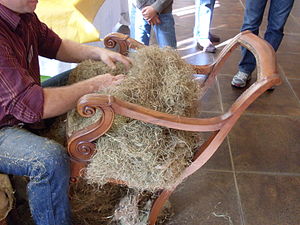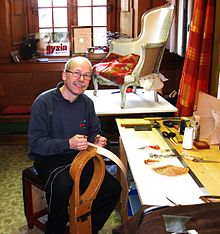Upholstery
Bolster the occupation of upholsterer or interior decorator . The upholsterer works in industry , the interior decorator in the trade .
Upholstered furniture, chairs and mattresses (pads) are produced. The manufacture and refurbishment of upholstery in the automotive sector is carried out by the vehicle saddler.
technology
In this professional field, too, work technology has changed over the past hundred years. Initially, only pieces of leather were nailed to a wooden frame for seats and benches. Later, different materials such. B. Straw, seagrass and horsehair are padded for comfort. The historical forerunner of the upholsterer was the profession of chair maker , who built the wooden frame of the seating furniture.

Up to around 1960, the production of upholstered furniture was as follows: Straps are stretched crosswise and fastened with strap nails on a frame made of hardwood (mostly beech , with visible wooden parts also cherry , oak , teak and others) . Spring springs are sewn onto these belts . To give these feathers support, they are tied to each other (and usually also to the frame). Various lacing techniques have developed here. A distinction is made between the German and the French lacing.
- The German lacing is also called mattress lacing. It is usually used in very deep and straight seats or lounge furniture and can be recognized by the diagonal intermediate cord.
- The far more frequently used lacing is the French lacing for smaller furniture (up to 4, maximum 5 rows of springs).
By means of different types of knots ( knot , loop , bean, double bean) the springs are brought into the shape that corresponds to the later furniture. It is interesting that the springs are not vertical. They are aligned in such a way that they assume the vertical position “when sitting”, ie when pressing down, and thus enable maximum seating comfort. This technique is far superior to today's (innerspring) in terms of durability and convenience. However, due to the high level of manual work involved, it has become more expensive.
A jute fabric cover (spring linen 365/120, hessian bugging, canvas binding) is applied to this spring construction. In order to avoid friction and thus premature wear, this fabric is sewn to the springs or the edge wire. Only then is the spring line nailed to the frame with appropriate slack. A loose material made of African (palm fibers) or coconut is applied to this fabric and plucked evenly. A lassier stitch is used to facilitate the application of the material; this creates "compartments" into which the filling material is introduced. Another layer of jute fabric follows. The Fasson linen (210/120) is a supple, coarsely woven linen, which adapts perfectly to the desired shape without wrinkling. This is now "garnished": the filling material is brought into shape with a special hand sewing technique (ladder stitch / front stitches / back stitch and, in the case of Empire furniture , a pork back stitch for a "sharp edge").
The result is the "Fasson" (French: shape). The final shape of the upholstered furniture is now complete. To further increase the seating comfort, lassier stitches are applied again to attach a layer of horsehair or elancrin (refined coconut fiber). This is called pricking. The material is also plucked evenly for this purpose. The finish is a layer of soft upholstery wadding (consists of cleaned, then shredded old clothing, wool and various animal hairs). It is advisable to put on a white cover before putting on the furniture fabric. This is done with nettle . The advantage here is that you can work out the shape of the seat nicely, and it also makes it easier to unplug (staple) the cover material. Furthermore, this separate cover extends the durability of the cover material to a not insignificant extent. For very fine fabrics such as B. Damask or brocade fabrics, the white cover is even strongly recommended. Very high-quality upholstered furniture or antiques are sometimes only stored or offered with a white cover, as the final cover material should be selected by the buyer. The labor costs for the cover are usually already included in the purchase price, only the desired cover material must then be paid for separately.
The actual furniture fabric cover is - depending on the furniture shape - nailed / stapled and / or sewn on. Before doing this, the offsides, i.e. the back and the side parts of the piece of furniture, are sealed with cardboard and the latter padded. This is followed by the fabric cover (tension parts). Visible seams are decorated with trimmings such as cords , gimp , braid , border or piping ( piping ). Such a concealment of the attachment points is more likely to be considered improper. Specialists sew the outer clamping parts by machine and cover the entire back side with a piece of furniture fabric. The latest and most modern finish is the double piping. For this, a strip of fabric is sewn around a profile. The double welt is then stapled in the groove of the profile. The pressure of the clamps press the two beads against each other and cover the clamps.
Decorative nails are available in different designs for visible nailing.
The artisanal type of upholstery described is far superior to the techniques used in industrial furniture production in terms of durability and seating comfort. Due to the high workload, it is of course also expensive and is therefore mainly used for the restoration of antiques or very exclusive new products.
Tool
The upholsterer gets by with relatively few tools. But that should be available in good quality. Here is an overview of the most important tools:
- hammer
- A good upholstery hammer with a round head 8 mm for driving in the double nails; for the belt nails you need a stronger one with 13 mm. A peen hammer for hammering of rivets or eyelets and a wooden hammer for demolition work with the goutweed .
- Scissors
- Good cutting scissors with long blades for cutting the upholstery fabric. A smaller one for fine work and a handy little one for working with the sewing machine.
- Pliers
- Diagonal cutters are useful for removing the staples. Flat or combination pliers for various work on fabric or leather. Pliers are also ideal for demolition work on larger nails.
- Awls and screwdrivers
- Screwdrivers of all sizes in slotted, cross or Torx versions are important. A sharp awl is used to loosen the clamps.
- Cow foot
- This tool, also known as the goat's foot, is needed to remove the nails. It is important that you use it with a mallet. This is easy on the tool and the mallet is much lighter. A similar tool is the breakaway iron. With this you can remove panels or the like from the frame.
- knife
- Good, sharp knives are ideally suited for cutting off excess material. You can use a box cutter or a so-called crescent moon. A small carving knife works well for hard-to-reach places.
- Saws and rasp
- For trimming the edges of the wire is a small hacksaw needed. An electric foam saw is ideal for cutting foam. A hand saw or a sharp knife are also sufficient for straight cuts. A wood rasp is needed to round off sharp wooden edges.
- Needles
- A good assortment of curved upholstery needles and mattress needles with round and triangular tips in all sizes and strengths are required for hand sewing and shaping work. A double point is required to sew through the upholstery and to pull in the upholstery buttons. This needle has a point at each end. It is important to work carefully with this needle because of the risk of accidents. Stable pins are required to attach the cushions.
- Special tool
- The belt tensioner , a piece of wood with sharp nail ends, is required to tension the jute belts. They are available with a fold as a guide on the wood of the frame or with rubber coating. This protects the visible wood from scratches or pressure points. The edge wire bender is required to bend the edge wire. It can be used to achieve good wire curves. A hot glue gun is good for gluing cords and decorative ribbons.
- sewing machine
- A good sewing machine with a table is the heart of every upholstery shop. It should also be able to sew thick upholstery or leather without any problems. A knee lever with which the presser foot can be raised is ideal; so the upholsterer always has both hands free and can sew quickly.
- Screw press
- This press can be used to punch holes and also produce upholstery buttons, snaps and eyelets.
Apprenticeship in Germany
The upholsterer has been a state-recognized training occupation in Germany since 1997 according to the Vocational Training Act . Previously, the profession was recognized from 1937, well before the Vocational Training Act came into force. In 2005 there was a change in the training regulations, with which a completed training in the new, two-year occupation of upholstery and decoration sewer could be counted towards the training period. In 2013 and 2014, the training content was fundamentally revised to meet the changed technical and organizational requirements of the industry. The training takes place at the company and vocational school and lasts three years.
Apprenticeship in Austria
In Austria, upholsterer is a three-year apprenticeship . The training takes place in the dual system at vocational schools and at relevant companies in the upholstered furniture industry, at upholstered furniture workshops or upholstery companies. The contents of the training include techniques for manufacturing and repairing upholstered furniture, mattresses, wall and door upholstery, taking into account the style of the different historical epochs. The apprentice ends their training with the final apprenticeship examination as a journeyman.
An additional qualification can be acquired through a further examination in the related apprenticeship upholsterer and decorator. In the craft of upholsterers and decorators, the master's examination can also be taken, and independent professional practice is also possible.
For higher qualifications at colleges, technical colleges and universities in Austria you usually need the vocational matura (vocational maturity examination), which consists of the final apprenticeship examination and four other exams.
See also
literature
- Klaus Pracht, Friedrich Wilkening: Textile interior design. Upholstery, decorating, covering. Bauverlag, Wiesbaden and Berlin 1988, ISBN 3-7625-2614-1 .
- Helmut Schröter: upholstery technology and interior decoration. VEB Fachbuchverlag, Leipzig 1989, ISBN 3-343-00066-3 .
- Henner Reitmeier: Upholstery. In: Ders .: Der Große Stockraus. A relaxicon. Berlin 2009, page 177.
Movies
- The upholsterer from Zolling . D, 2008 (documentation, 30 minutes), Bayern3 from the series " The last of his booth ?"
- Craftsmanship! How to upholster an armchair , SWR Fernsehen - Landesschau Rheinland-Pfalz from July 23, 2018
Individual evidence
- ↑ raumeinrichtung.de: white upholstery , living encyclopedia
- ↑ Ordinance on vocational training as an upholsterer in the industry ( Memento of the original from February 22, 2014 in the Internet Archive ) Info: The archive link has been inserted automatically and has not yet been checked. Please check the original and archive link according to the instructions and then remove this notice. at juris (PDF), accessed on February 13, 2014.
- ^ Ordinance on professional training for upholstery and decorative sewing , website of the BiBB, (PDF), accessed on February 13, 2014.
- ↑ Development of upholstery training , website of the BiBB, accessed on February 13, 2014.
- ↑ Reitmeier's view can also be read online , accessed on June 22, 2012.
Web links
- Upholsterer profile (bundesarbeitsagentur.de, as of August 2, 2010; PDF; 841 kB)
- Lexicon of textile furnishings - upholstered furniture category
- Finkeldei upholstered furniture lexicon
- Professional and industry information from the Austrian Chamber of Commerce
- detailed education and training information for Austria from the Institute for Economic Research







